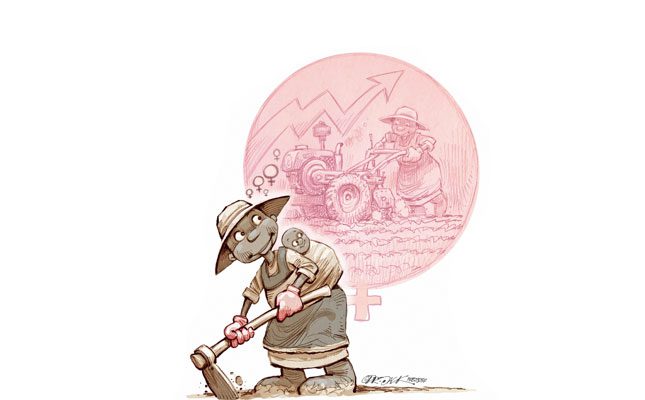
The world is beginning to recognise that the face of African farming is female. In some parts of Africa and Asia, women constitute up to 60% of the agricultural labour force. They also grow about 70% of Africa’s food, and contribute 21% of sub-Saharan Africa’s gross domestic product.
Women farm for household consumption, for commercial purposes, they work as farm labourers to earn incomes, and they trade. However, many of them, particularly those in rural Africa, have limited access to resources to make farming a productive endeavour.
Barriers to growth
The Food and Agriculture Organization of the United Nations estimates that if women had the same access as men to production resources such as information, seeds, fertiliser, extension services, markets, and technologies, agricultural yields on their farms could increase by between 20% and 30%.
One major constraint preventing women from accessing these resources is how to balance household responsibilities, such as looking after their children, cooking and cleaning, with agricultural activities. Often, women are unable to travel long distances to access markets in order to sell produce or purchase inputs such as fertiliser and seeds.
They also often cannot take significant time away from their homes to participate in agricultural training. However, ongoing innovation and new technologies could reduce travel time to markets and help women access other resources necessary for enhancing their agricultural productivity.
The theme for this year’s International Women’s Day, celebrated annually on 8 March, was ‘DigitALL: Innovation and technology for gender equality’. Digitalisation takes systems or processes and adapts them so that they can be operated by computers.
Digitalisation thus makes complex processes easier to manage. For example, instead of calling a taxi company to make a reservation, most people nowadays simply pull out their phones and request a ride via an e-hailing app.
Such technologies can improve women farmers’ connections to markets and training services. Imagine a women farmer in a remote area being able to use her smartphone to request the delivery of fertiliser via Uber, or to sell her produce using an application that links her to a buyer in seconds.
Technology is fundamental to improving women’s agricultural productivity, but in the development of such technology we need to bear in mind women’s social and cultural contexts.
For example, mobile phones have an extensive reach in Africa and have penetrated even the most remote areas. Globally, they are providing valuable agriculture-related information, early disaster warnings, and so on.
However, according to data from 2017, in sub-Saharan Africa, women were 14% less likely to own a mobile phone than men were, and 25% less likely to have Internet access.
In a recent study that our Food Systems Research Network for Africa research team conducted in Ghana, we found that not many people have access to smartphones.
Therefore, while agricultural digitalisation is the ideal solution, it will take time to become a reality for many rural African communities.
Alternative technologies
Low-hanging fruit exists to advance digitalisation in conjunction with automation. Automation makes existing tools easier to use. For example, instead of using a sickle, a mini combine harvester (a compact, car-like machine) can be used to harvest crops. This not only makes the harvesting process less tiring, but also more efficient.
Another example is rice-milling operations, which involve intense manual labour in the operation of the mill. At a typical rice mill, women are tasked with measuring rice into sacks and then completing the bagging process. If the mill were automated, the process would be more efficient, as it would take less time and effort to bag the rice.
It is comparatively easier to implement automation than digitalisation in terms of the level of technology required and the initial funds that need to be invested.
While a simple knapsack sprayer can be automated to ensure its operation isn’t manual, introducing sensors on the farm to aid the digitalisation of the application of chemicals would be more cost-intensive.
Investment is more significant for digitalisation than automation because automation can easily be achieved by adapting or improving existing equipment.
While both types of technologies would require some level of training for uptake, automation might be more readily adopted, as it uses equipment and tools that communities are already familiar with.
Similarly, adapting existing automated technologies for use by women could increase their uptake of technologies to enhance their productivity. For example, our study in Ghana found that it was socially inappropriate for women to use power tillers because of the level of vibration and physical stress of operating this equipment. Consequently, women generally don’t own such equipment because it is not culturally acceptable.
Both automation and digitalisation can mitigate the challenges associated with women’s use and ownership of such technologies, by reducing the level of effort required to operate the equipment and thereby increasing the degree of social acceptance.
However, automation will achieve this in a more cost-effective way. For example, the power-steering mechanism used in cars can be adapted for use in power tillers. This technology would make the latter easier to operate for both men and women, and make its use by women more culturally acceptable.
Digitalisation, on the other hand, would require new equipment, access to smart technologies, and training on how to use the technology. While digitalisation is essential for women in agriculture, the current context in Africa suggests that it will take time and significant investment to achieve this.
In complement to digitalisation efforts, automation technologies and innovations can increase women’s productivity and agricultural yields more immediately and at a lower cost. As we aim to meet the “digitALL” standard, where everyone has equal access to digital innovation and technology, we must take advantage of low-hanging fruits that will support women in the interim.
The views expressed in our weekly opinion piece do not necessarily reflect those of Farmer’s Weekly.
Dr Elizabeth Mkandawire is a research assistant at the University of Pretoria’s (UP) Institute for Food, Nutrition and Well-being. She is also the network and research manager for the Food Systems Research Network for Africa (FSNet-Africa), a collaborative project between the UP, the University of Leeds in the UK, and the Food, Agriculture and Natural Resources Policy Analysis Network.
Dr Selorm Dorvlo is a lecturer in the Department of Agricultural Engineering at the University of Ghana and a fellow in the FSNet-Africa project.












